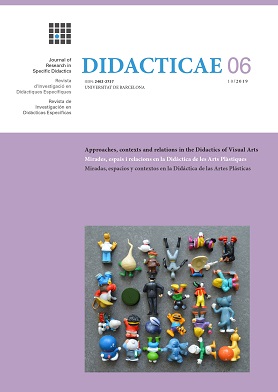Una experiencia de concienciación fundamentada en la creación de recursos educativos abiertos desde la Educación Visual y Plástica
An awareness-raising experience in Arts Education based on the creation of open educational resources
DOI:
https://doi.org/10.1344/did.2019.6.22-36Keywords:
open sources, Plastic and Visual Arts, digital image, Open Educational Resources, ICTAbstract
In this first decade of the 21st century, the impact of open policies and their effects on the education systems around the world has become a topic of interest thanks to the efforts and leadership of various organizations and projects promoting learning through open content. OER Commons, The Saylor Foundation, Wikieducator, Europeana, Learning Resource Exchange (LRE), Procomún or Khan Academy are just a few current significant examples of this trend. Open education should be closer than ever to achieving the strategic opportunity that it represents, and which would definitely improve the quality of education. But it seems that its implementation is not just generalized, as we can see in this context of higher education. This article is based on the experience carried out in the Faculty of Education of the University of Barcelona with the students of the subject Digital Image and Learning (6 ECTS) of the Arts Education speciality to reflect on this issue.
References
Abadal, E., Ollé Castellà, C., Abad-García, F., y Melero, R. (2013). Políticas de acceso abierto a la ciencia en las universidades españolas. Revista Española de Documentación Científica, 36(2), e007. doi: http://dx.doi.org/10.3989/redc.2013.2.933
Area, M., y Ribeiro, M. T. (2012). De lo sólido a lo líquido: las nuevas alfabetizaciones ante los cambios culturales de la Web 2.0. Comunicar, 38, 13-20. doi: http://dx.doi.org/10.3916/C38-2012-02-01
Cabero, J. (Ed.). (2001). Tecnología educativa: diseño y utilización de medios en la enseñanza. Barcelona: Paidós.
Conole, G. (2010). Learning design – making practice explicit. En ConnectEd Design Conference, 28 de junio – 2 de julio 2010. Sydney, Australia. Recuperado de http://oro.open.ac.uk/22890/2/Conole.pdf
Cruz, V. (2011). Competencia para el diseño y producción de recursos digitales [objetos de aprendizaje]. Recuperado de http://catedra.ruv.itesm.mx/handle/987654321/368
Deloche, B. (2002). El museo virtual. Hacia una ética de la nueva imagen. Gijón: Trea.
Dondis, D.A. (1990). La sintaxis de la imagen. Introducción al alfabeto visual. Barcelona: Gustavo Gili.
D’Antoni, S. (2006). The virtual university. Models and messages. lessons from case studies. Paris: Unesco Publishing. Recuperado de https://unesdoc.unesco.org/ark:/48223/pf0000146558
De los Arcos B., Farrow, R., Perryman, L.-A., Pitt, R., Weller, M., y McAndrew, P. (2015). OER research hub data 2013-2015. Building understanding of Open Education. OER research hub. Recuperado de https://oerknowledgecloud.org/sites/oerknowledgecloud.org/files/20151117-OER-Hub-Data-Report.pdf
European Union (2016). Assessment of the impact of the European copyright framework on digitally supported education and training practices. Directorate-General for Education, Youth, Sport and Culture (European Commission). Luxemburg: Publication Office of the European Union. doi: 10.2766/453732. Recuperado de https://publications.europa.eu/en/publication-detail/-/publication/1ba3488e-1d01-4055-b49c-fdb35f3babc8
Hylén, J., van Damme. D., Mulder, F., y D’Antoni, S. (2012). Open Educational Resources: Analysis of responses to the OECD Country Questionnaire. OECD Education Working Papers, 76. Paris: OECD Publishing. doi: http://dx.doi.org/10.1787/5k990rjhvtlv-en
Jenkins, H. (2009) Fans, blogueros y videojuegos. La cultura de la colaboración. Barcelona: Paidós comunicación.
Kress, G., y van Leeuwen, T. (1996). Reading images: The grammar of visual design. Londres: Routledge.
Kress, G. (2005). El alfabetismo en la era de los nuevos medios de comunicación. Málaga: Aljibe.
Labastida, I., e Iglesias, C. (2006). Guía sobre gestión de derechos de autor y acceso abierto en bibliotecas, servicios de documentación y archivos. SEDIC. Recuperado de http://hdl.handle.net/2445/32170
Nobre, T. (2017). Copyright and education in Europe: 15 everyday cases in 15 countries. Final report COMMUNIA. International Association of the Digital Public Domain. Recuperado de https://www.communia-association.org/wp-content/uploads/2017/05/15casesin15countries_FinalReport.pdf
OECD (2009). El conocimiento libre y los recursos educativos abiertos. Mérida: Junta de Extremadura. doi: https://doi.org/10.1787/9788469180822-es.
Open Society Foundations (2007). Declaración de Ciudad del Cabo para la Educación Abierta: Abriendo la promesa de Recursos Educativos Abiertos. Recuperado de url https://www.ca-petowndeclaration.org/read-the-declaration
Stallman, R. (2003). Why schools should exclusively use free software. GNU operating system. Recuperado de https://www.gnu.org/education/edu-schools.es.html
UNESCO (2002). Forum on the impact of open courseware for Higher Education in developing countries. Paris, 1-3 julio. Recuperado de https://unesdoc.unesco.org/ark:/48223/pf0000128515
UNESCO (2012). Declaración de París sobre los REA. Congreso mundial sobre los Recursos Educativos Abiertos (REA). Recuperado de http://www.unesco.org/new/fileadmin/MULTIMEDIA/HQ/CI/CI/pdf/Events/Spanish_Paris_OER_Declaration.pdf
UNESCO (2015a). Replantear la educación. ¿Hacia un bien común mundial? Recuperado de urlhttp://unesdoc.unesco.org/images/0023/002326/232697s.pdf
UNESCO (2015b). Guía básica de Recursos Educativos Abiertos (REA). Recuperado de url http://unesdoc.unesco.org/images/0023/002329/232986s.pdf
Wiley, D. (2000). Connecting learning objects to instructional design theory: a definition, a metaphor, and a taxonomy. En D. Wiley (Ed.) The instructional use of learning objects: online version. Recuperado de http://reusability.org/read
Wiley, D. (12 de febrero de 2016). Slow or sophisticated? Squandered or sustainable? [Entrada en un blog]. Recuperado de https://opencontent.org/blog/archives/4443
William and Flora Hewlett Foundation (2013). White paper: Open Educational Resources. Breaking the lockbox on education. Recuperado de https://hewlett.org/library/white-paper-open-educational-resources
Downloads
Published
Issue
Section
License
Copyright (c) 2019 Júlia Castell Villanueva

This work is licensed under a Creative Commons Attribution-ShareAlike 4.0 International License.
The authors who publish in this journal agree to the following terms:
- Authors retain copyright and grant the journal the right of first publication.
- Submitting a paper does not involve paying any fees.
- Texts will be published under a Creative Commons Attribution Share-Alike 4.0 International License that allows others to share the work, provided they include an acknowledgement of the work’s authorship, its initial publication in this journal and the terms of the license.
- When citing works published in Didacticae, both the autor and the journal must be cited.
- Didacticae does not accept any responsibility for the points of view and statements made by the authors.



